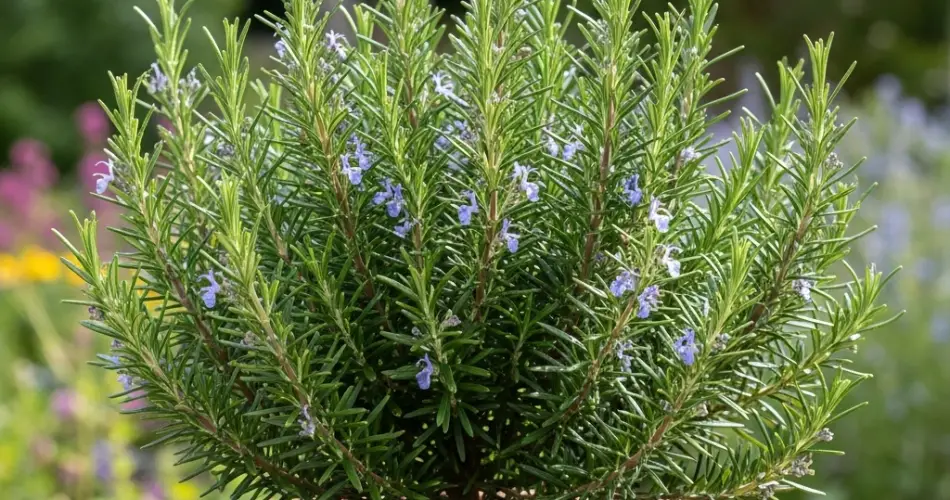Rosemary is a fragrant, hardy herb widely used in cooking and natural remedies. Its needle-like leaves and woody stems not only add flavor to dishes but also bring a lovely aroma to your home or garden. Even if you have no prior gardening experience, rosemary is one of the easiest plants to care for, making it a perfect choice for beginners. This guide will help you learn how to successfully grow and maintain rosemary, ensuring a thriving plant that will provide beauty and flavor for years to come.
Why Choose Rosemary?
Rosemary is a resilient herb that thrives in a variety of conditions. It tolerates drought well and doesn’t require much fertilizer. Whether grown indoors or outdoors, rosemary can flourish with minimal effort, making it ideal for anyone new to gardening. Besides culinary uses, rosemary has antimicrobial and antioxidant properties, and many people enjoy its natural air-freshening qualities.
Selecting the Right Rosemary Plant or Seeds
If you’re starting out, you can either grow rosemary from seeds or buy young plants from a nursery.
-
Seeds: Growing from seed takes longer and requires patience, as rosemary seeds germinate slowly (often 2-4 weeks) and seedlings grow gradually.
-
Young Plants: Buying a healthy rosemary plant gives you a head start and is easier for beginners.
Look for plants with vibrant green foliage and no signs of pests or disease.
Choosing the Right Location
Rosemary loves sunlight. Aim for a spot that receives at least 6-8 hours of direct sunlight daily.
-
Outdoors: A sunny garden bed or raised container with good drainage is ideal.
-
Indoors: Place rosemary near a south- or west-facing window where it will get ample light.
If you don’t have enough natural light indoors, consider supplementing with a grow light.
Soil and Container Requirements
Rosemary prefers well-draining soil with a slightly acidic to neutral pH (6.0 to 7.0).
-
Use a sandy or loamy soil mix rich in organic matter.
-
Avoid heavy clay soils that retain water and cause root rot.
-
If planting in pots, ensure containers have drainage holes to prevent waterlogging.
Planting Rosemary Properly
When planting rosemary, whether from seed or transplanting young plants, follow these steps:
-
Loosen the soil and mix in compost or aged organic matter.
-
Plant rosemary slightly deeper than the root ball’s original depth.
-
Water thoroughly after planting to settle the soil around the roots.
Watering Rosemary
One of rosemary’s key traits is its drought tolerance. Overwatering is a common mistake that can kill the plant.
-
Water rosemary deeply but infrequently. Allow the top inch of soil to dry out before watering again.
-
In hot weather, watering once a week is usually enough; adjust as needed for your climate.
-
Indoors, ensure pots don’t sit in standing water.
Fertilizing Rosemary
Rosemary is a light feeder and doesn’t require frequent fertilization.
-
Use a balanced, slow-release fertilizer once in spring.
-
Alternatively, feed with a diluted liquid fertilizer every 6-8 weeks during the growing season.
-
Avoid over-fertilizing, which can reduce the plant’s flavor intensity.
Pruning and Harvesting
Pruning rosemary encourages bushier growth and keeps plants healthy.
-
Trim back the plant regularly, especially new growth, to maintain a compact shape.
-
Harvest sprigs by cutting just above a leaf node. This promotes new growth and prevents the plant from becoming woody.
-
Avoid heavy pruning in late fall or winter, as the plant slows growth during this time.
Dealing with Common Issues
-
Pests: Rosemary is generally pest-resistant but can occasionally attract aphids, spider mites, or whiteflies. Use insecticidal soap or neem oil to treat infestations.
-
Diseases: Overwatering and poor air circulation can cause root rot or powdery mildew. Ensure proper watering and ventilation.
-
Yellow Leaves: This may indicate overwatering or nutrient deficiency. Adjust watering and consider light feeding.
Tips for Indoor Rosemary Care
-
Place near bright windows or use grow lights for at least 6 hours of light daily.
-
Keep indoor air dry or use a fan to improve air circulation.
-
Avoid placing rosemary near drafts or heating vents, which can stress the plant.
Propagating Rosemary
Propagation is a rewarding way to multiply your rosemary plants.
-
Take 4-6 inch cuttings from healthy stems.
-
Remove leaves from the bottom half and place cuttings in water or moist soil.
-
Roots develop within 2-4 weeks; transplant rooted cuttings into pots.
Propagation allows you to grow new plants for your kitchen, garden, or sharing with friends.
Seasonal Care
-
Spring and Summer: Active growing season. Water moderately, fertilize lightly, and prune regularly.
-
Fall and Winter: Reduce watering and stop fertilizing. Protect outdoor rosemary from frost by moving pots indoors or covering garden plants.
Summary
Rosemary is an excellent herb for beginners thanks to its resilience and low-maintenance nature. By choosing the right location, watering correctly, pruning regularly, and watching for pests, you can enjoy a thriving rosemary plant even without any prior gardening experience. With time, you’ll find that caring for rosemary is not only simple but also rewarding, providing fresh herbs and a pleasant aroma for your home.



